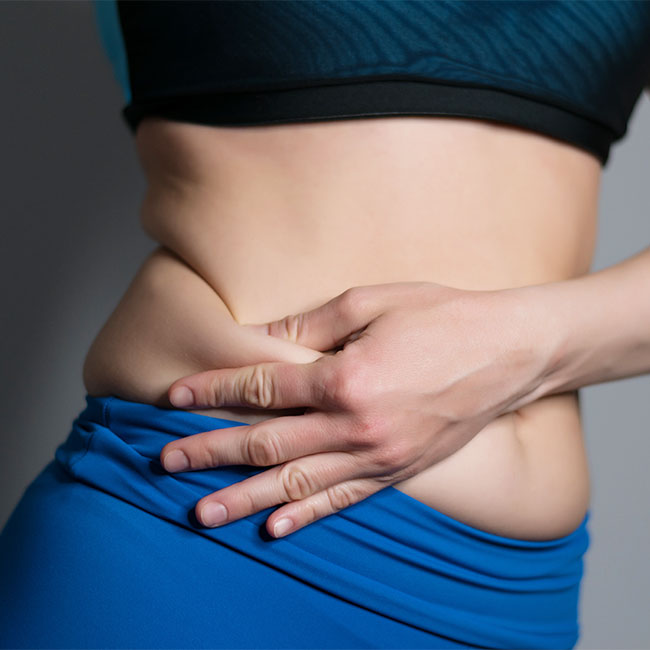Losing weight is difficult enough on its own, and many people find that targeting a specific area of their body for fat loss can feel overwhelming and daunting. We checked in with personal trainers and health experts for tips, suggestions and reasons why you might not be losing weight in your midsection despite all your hard work and efforts. (Before diving into it, please pat yourself on the back as prioritizing your health and fitness is admirable and worth celebrating!) Read on for insight and advice from Christine VanDoren, CN, CPT, certified personal trainer and nutritionist and Seamus Sullivan, B.S., CSCS, PN1, online performance and nutrition coach.
First Off, How & Why Does Mid-Section Weight Gain Occur?
Before diving into reasons why you might not be losing weight in the area, it’s important to think about why it might gather there in the first place. “Most people gain weight in their mid-section first, and it can be quite frustrating when it doesn’t want to come off despite your best efforts,” VanDoren acknowledges. However, she stresses, it’s important to keep in mind that you cannot tell your body where to lose fat first. “It really is up to your genetics whether you lose fat in certain places before others or you lose it gradually on your whole body as you are in a caloric deficit,” she adds. So, do not get discouraged, she says, if you see others “losing weight easily on their abdominals” while you might have to work a little harder for it.
Another quick tip to remember, VanDoren notes, is that many women on their period might mistake water weight or bloating as fat gain. “You may also simply be bloated, especially if you are on your menstrual cycle. Many women hold onto a lot more water when they are on their period, and this can make it seem like they have gained weight on their mid-sections when really it will go away in a week or so,” she says. “You may also appear bloated if you are holding onto water in general or have digestive issues.” Apart from this, we’ve rounded up 4 main reasons why you might not be losing weight in your mid-section/ midriff area and other helpful steps to take in order to successfully to do so.


1. Spot Reduction Really Isn’t A Thing
As much as programs, ads or certain shows might promote products that flush out or cause weight loss in a certain area, it’s more logical (and possible) to aim for general weight loss and utmost health instead, Sullivan says. “There is no such thing as spot reduction, this means that a person who is trying to lose body weight and fat cannot simply choose the area they want to decrease,” he says. “No matter how many core exercises or ab routines they do, that area will not specifically reduce like they want,” he adds, saying that people should also be “wary of waist trainers” as they do not in fact “reduce belly fat either.” If anything, he says, you may be putting your organs in danger. VanDoren agrees and says that “you need to be in a caloric deficit to lose weight in general,” and that including “progressive overload in your program” can “ensure you are burning fat efficiently.”

2. You’re Not Actually In a Caloric Deficit
Even though one may move and eat healthy, Sullivan says it all comes down to “math” with one's calories. “A person needs to be in a caloric deficit to elicit weight loss and thus drop body fat,” he explains. “One needs to be careful, however, as most can actually mess up their metabolism if they do not do this properly.” From his experience, Sullivan tells us he has seen “lots of people over-do the training and under-eat,” leaving no room for recovery, which is a “disaster waiting to happen.” Have appropriate calories and balanced macronutrients, he advises, as once this is set, a person can then go into a “deficit to start losing weight and losing body fat.” VanDoren adds that doing both strength training and cardio can help with this, as well as drinking a gallon of water every day to “provide the body with a consistent and abundant source” while you workout and go about your day.

3. You’re Not Tracking Your Progress
Even if you don’t see instant changes overnight, jotting down your accomplishments (both big and small) can help you in the long run, Sullivan says. Once a person understands the myth of spot reduction and how to be in a caloric deficit, he adds, they still need to actually track their progress. “Some may just see the scale once in a while or only look in the mirror at their stomach occasionally— a person needs to make it a habit to get on the scale every day, best is after the restroom in the morning, take some transformation photos every 2 weeks and measure,” he suggests. This is then an objective measurement, he continues, as they can see the trends of their weight loss, “because some days will be way different due to food, hydration or even time of month.”
This, he says, is where photos come in. “Taking photos every few weeks helps a person visualize the change in their body even though the scale may not be where they like,” says Sullivan. “Even though this is about fat loss in the midsection, a person should celebrate the small wins if they see their shoulders, arms and legs looking better while the midsection may look the same. Lastly, they need to see the numbers with a measuring tape.” If a person has not done this, he stresses, “how would they actually know they are not losing in that area?” Getting the measurement tape out and checking every 2 weeks is “fine,” like with the photos, he notes, as these “objective measurements will be ideal habits” to actually see the results in the body and midsection.

4. You’re Impatient
Believe us, we know how hard this realization is. Wanting your ideal body often means wanting it *now,* but unfortunately, this isn’t the case as diligence, consistency and patience are all key with healthy weight loss. “You need to be patient,” Sullivan says, ad “some folks” are just generally disposed to have more body fat on their midsection than others (and that’s okay!) He provides a helpful analogy: “If someone lined up 100 people of the same height, weight and body fat percent, they would have a different make-up genetically. Some would hold more fat in the arms, stomach, butt or even legs. A person just needs to understand that they just have a different story and journey when it comes to fat loss,” he says. Knowing your body type, dressing *for it* rather than *against it* and embracing it will help you on the journey, experts say.
In conclusion, Sullivan says that you “may just need to create a longer time horizon with your health goals and not expect it to happen as quickly as some would say.” VanDoren concurs, adding that it’s also important to not “pay too much mind to your appearance or weight” when you are on your period, to “get enough sleep” and to “visit your physician” if you think you may have digestive issues that you can fix. Overall, you got this! (Even if it feels like you don’t, as you’re not alone in this journey or with your health goals).


























